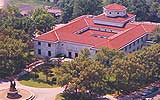Faculty
Christopher Drew Armstrong
(PhD, Columbia University) Director of Architectural Studies and Assistant Professor, 18th and 19th-century European and North American art and architecture
Room 110, Frick Fine Arts Building
Phone: 412-648-2402
E-mail: cda68@pitt.edu
In the early modern era, architecture and landscape design offered rich fields for experimentation with new models of perception. Christopher Drew Armstrong’s work investigates approaches to observation and the experience of art and architecture in the 18th and 19th centuries. He is especially interested in the construction of the ‘self’ and how this concept shapes the relationship of the individual to temporal and spatial phenomena.
At Columbia, Armstrong worked with Robin Middleton and Barry Bergdoll on travel and the ‘discovery’ of Greek architecture in the18th century. As a master’s student at the University of Toronto, he worked with Douglas Richardson on the British Gothic revival and Hans-Karl Lücke on the mythological frescos of the Venetian artist Giambattista Tiepolo. Armstrong returned to Toronto as an SSHRC post-doctoral fellow where he worked with William McAllister Johnson and taught in the Department of Fine Art and the Faculty of Architecture, Landscape and Design.
Selected publications:
“Qui Transtulit Sustinet: William Burges, Francis Kimball and the Architecture of Hartford’s Trinity College,” Journal of the Society of Architectural Historians 59 (June 2000): 194–215.
“Projets inédits pour une Ecole de Navigation à la Malmaison, an VIII,” Bulletin de la Société des amis de Malmaison 34 (2000): 108–125.
Review of Frank Salmon’s Building on Ruins. The Rediscovery of Rome and English Architecture (London: Ashgate, 2000) in: Journal of the Society of Architectural Historians 61 (June 2002): 222–224.
Review of Douglas Ord’s The National Gallery of Canada. Ideas Art Architecture (Montreal and Kingston: McGill-Queen’s University Press, 2003) in: University of Toronto Quarterly 74 (Winter 2004/05).
“Travel and Experience in the Mediterranean of Louis XV,” in: William V. Harris, ed., Rethinking the Mediterranean (Oxford: Oxford University Press, 2005), 235–67.
“Espaces et la longue durée: Leroy et l’histoire de l’architecture,” Livraisons d’histoire de l’architecture 10 (June 2005).
“Myth and the New Science: Tiepolo, Vico, and the Language of the Optimates,” The Art Bulletin 87 (December 2005).
“Il faut ruiner un palais.... Fragmentation and Human Nature in Leroy’s Les Ruines des plus beaux monuments de la Grèce,” in: Barry Bergdoll and Werner Oechslin, eds., Fragmentation. AFestschrift for Robin Middleton (London: Thames & Hudson, 2005).
“Portrait of the Architect as Revolutionary Hero: Antoine-Denis Chaudet’s Bust of Julien-David Leroy,” Journal of the Society of Architectural Historians (forthcoming).
Honors/Awards:
2003–2005: Social Sciences and Humanities Research Council of Canada Post-Doctoral Fellowship.
2001–2002: Whiting Foundation Fellowship.
1999–2000: John Soane’s Museum Foundation Fellowship.
1997–1998: Mellon Foundation Fellowship.
1995–1998: Social Sciences and Humanities Research Council of Canada Graduate Fellowship.
Current projects:
Armstrong is preparing a book that will explore the contribution of the French traveler and theorist Julien-David Leroy to late 18th-century neoclassical and ‘revolutionary’ architecture. A related project titled Mediterranean Exploration in the Early Enlightenment will examine cartography and the representation of space in the context of French commercial, diplomatic and scientific interests. He continues to work on Gothic-revival architecture in America and plans to publish a book on the Connecticut State Capitol and late 19th-century Hartford.
